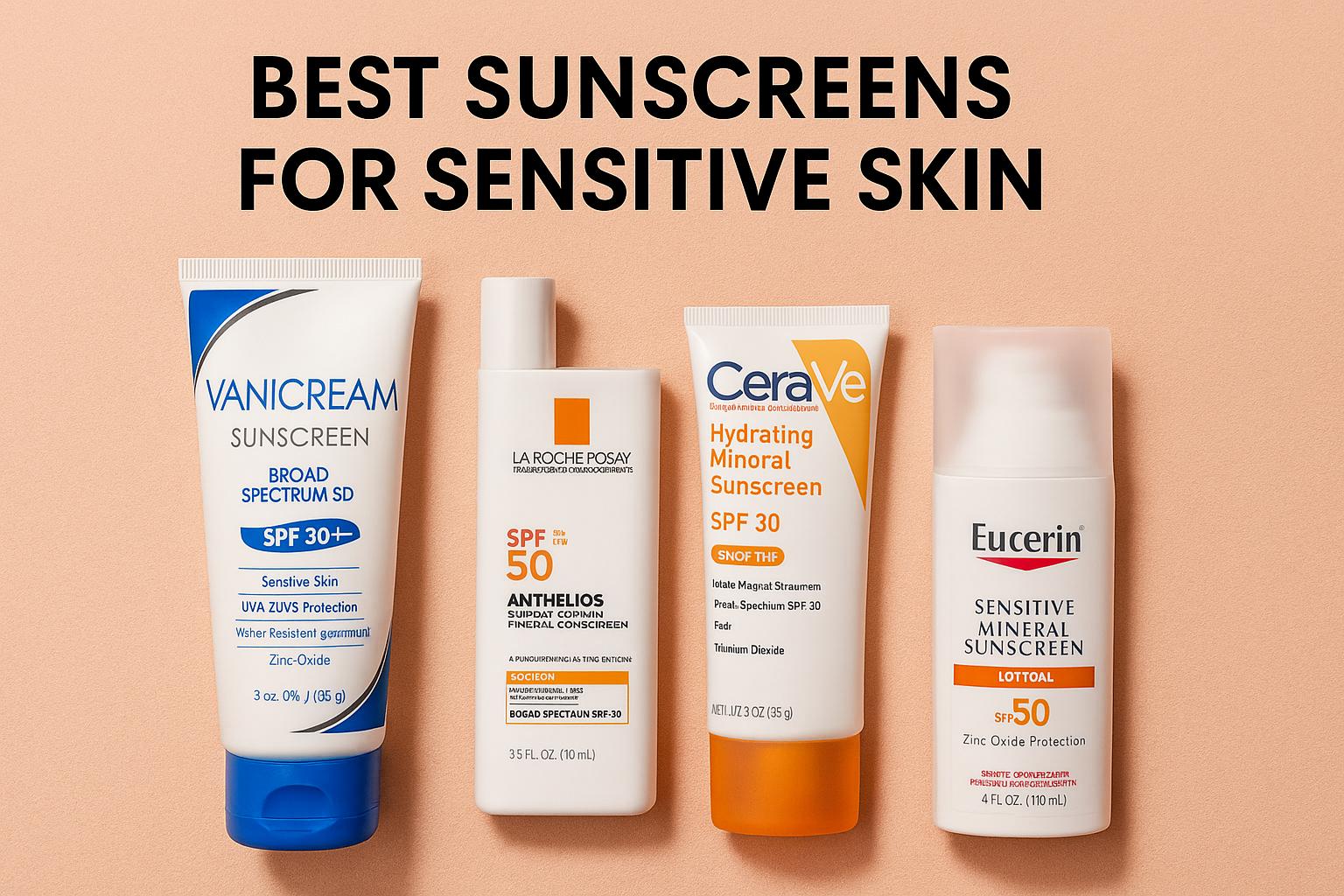Sunscreen Ingredients for Sensitive Skin
Selecting the appropriate sunscreen is a crucial step for individuals with sensitive skin, where the objective is to minimize any potential irritation while securing adequate sun protection. The key is to identify products that include ingredients known for their gentleness on sensitive skin.
The Value of Physical (Mineral) Sunscreens
Physical sunscreens are often recommended for those with sensitive skin due to their unique application mechanics. They feature active ingredients like zinc oxide and titanium dioxide, noteworthy for their ability to sit on the skin’s surface rather than absorb into it. Once applied, these components reflect ultraviolet (UV) rays from both UVA and UVB spectrums, akin to a mirror shield, providing instant protection. These ingredients are less intrusive, reducing the likelihood of irritation associated with their chemical counterparts. This characteristic makes physical sunscreens a preferred choice for individuals with heightened skin sensitivity.
The Concerns with Chemical Sunscreens
On the flip side, chemical sunscreens operate differently. They absorb UV rays and convert these rays into heat, dissipating it away from the skin. The conversion process necessitates the use of various organic compounds, such as oxybenzone and octinoxate. These substances, while effective in sun protection, can be potential irritants, especially for those prone to sensitive skin conditions. Thus, individuals might experience allergic reactions or exacerbated skin sensitivity. For those with sensitive complexions, avoiding chemical sunscreens might be a prudent decision.
Fragrance-Free Formulations
The inclusion of fragrances in skincare products is a common cause of skin irritation for many, not just those with sensitive skin. For individuals with sensitive skin, choosing a sunscreen is particularly pivotal. Fragrances may introduce an array of unnecessary allergens and irritants. Prioritizing sunscreens labeled as fragrance-free or unscented is a straightforward measure to mitigate risks associated with irritation. This decision can significantly alleviate concerns of redness, itching, and general discomfort.
Hypoallergenic Products
Moving deeper into the realm of hypoallergenic scrutiny, let’s explore what the term truly means.
Understanding Hypoallergenic
Hypoallergenic products are specifically manufactured to minimize the probability of an allergic response. However, consumers should be wary as there is no strict regulatory definition or standard for hypoallergenic products. This means it’s vital to individually assess the ingredient list for substances known to cause personal irritation or allergic reactions. Interested individuals must perform a diligent review of each product’s formulation to ensure it aligns with their dermatological needs.
Non-Comedogenic Sunscreens
Individuals whose skin tends to be acne-prone or prone to clogged pores should opt for a sunscreen that is non-comedogenic. These products are crafted specifically to avoid blocking skin pores, thereby reducing the possibility of subsequent breakouts or inflammation. When selecting such sunscreens, seek out labels indicating the product is oil-free or claims that it won’t clog pores. This feature is advantageous in maintaining a lightweight texture on the skin, promoting comfort and continuous protection.
Physical vs. Chemical Sunscreens
The efficacy and adaptability of sunscreens can largely be delineated through their composition into either physical or chemical classifications.
Characteristics of Physical Sunscreens
Physical sunscreens, enriched with mineral agents like zinc oxide and titanium dioxide, offer an extensive barrier against both UVA and UVB rays. This sun protection method is perceived as more accommodating for sensitive skin audiences due to its minimal irritation risk and instantaneous protective qualities upon application. Furthermore, they are less susceptible to the degradation under sun exposure compared to their chemical counterparts.
Understanding Chemical Sunscreens
Chemical sunscreens boast a different mechanism—they rely on synthetic compounds to absorb UV radiation and transform it into heat, which is then expelled from the skin. Although effective, these sunscreens often consist of a medley of chemicals, including the likes of oxybenzone and avobenzone, posing potential irritation risks to those with sensitive skin types. As such, when formulating a sun protection regimen, individuals with reactive skin might consider abstaining from chemical sunscreen formulations.
SPF and Broad-Spectrum Protection
A common directive for sunscreen, regardless of skin type, is ensuring adequate SPF along with broad-spectrum coverage. For individuals with sensitive skin, a balanced approach is essential.
The Role of SPF
Sun Protection Factor (SPF) is a relative measure of protection from UVB rays only, implying the direct cause of sunburn. For daily use, dermatological guidelines advise an SPF of at least 30 to offer ample protection without fostering irritation or other sensitivity concerns. This level of SPF is deemed optimal for preventing UV-induced damage.
Broad-Spectrum Necessities
Broad-spectrum sunscreens extend their protective prowess across both UVA and UVB rays, the former responsible for premature skin aging and the latter for sunburn. Combining broad-spectrum formulations with appropriate SPF levels is crucial to safeguard sensitive skin comprehensively. This means defending against sunburn while thwarting the aging effects of prolonged sun exposure.
Reapplication Considerations
To maintain its efficacy, it is important to recognize sunscreen’s requirement for reapplication during extended sun exposure. Application should be generous, covering all exposed skin, and reapplied every two hours. Activities that accelerate sunscreen depletion, such as swimming or excessive sweating, necessitate more frequent reapplications. This approach ensures sustained protection, helping sensitive skin avoid undue harm from the sun.
In conclusion, selecting a sunscreen tailored to sensitive skin entails looking for formulations with physical blockers such as zinc oxide or titanium dioxide, those devoid of fragrances, categorized as non-comedogenic and hypoallergenic, and boasting broad-spectrum and sufficient SPF coverage. Incorporating these elements into daily sun care practices helps maintain effective skin defense against harmful UV impacts, while reducing risks of irritation and allergic manifestations.




